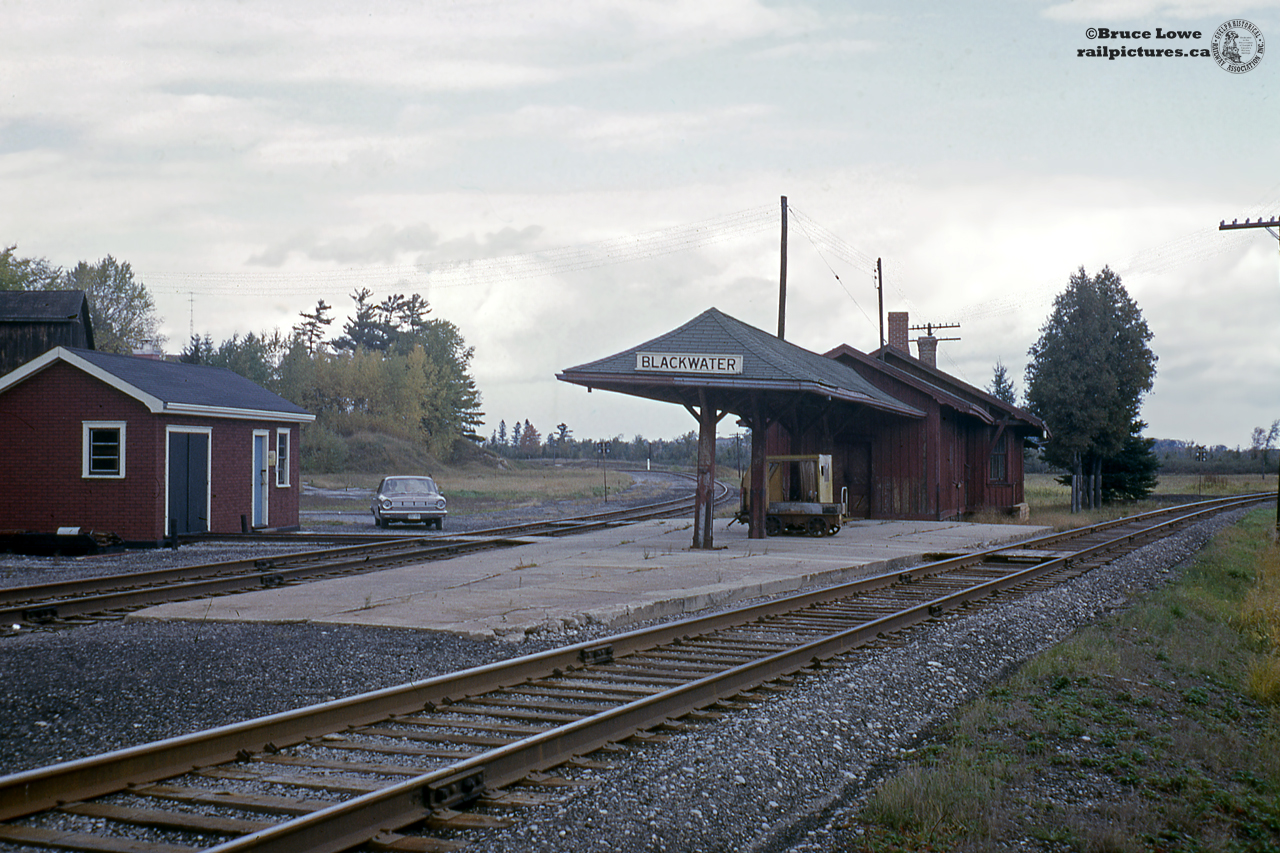|
Caption: A quiet day at Blackwater Junction finds Bruce and family (in car) making a quick stop by the CNR station, out of use by this time. The line at right is the Uxbridge sub, mile 18.69, and at left the Coboconk Sub, mile 0. At left is the section crew's shed for their speeders, both of which are sitting on the station platform. One older model; open with only front windshield, and one newer enclosed model. The original station, built by the Toronto and Nipissing Railway in 1871 was named Wick and would be replaced by this structure in 1874 once the Port Whitby & Port Perry Railway reached Wick Junction. Both merged into the Midland Railway in 1882 before the Grand Trunk would take over in 1884 and eventually Canadian National in 1923. With the end of passenger service, the station was closed in the early 1960's and demolished about a decade later.
Rails through this area began as the narrow gauge Toronto & Nipissing Railway in 1868 headed by George Laidlaw (also in charge of the narrow gauge Toronto, Grey & Bruce Railway), opening from Scarboro Junction; mile 60.56 Uxbridge sub, mile 325.05 Oshawa Sub, to Uxbridge at mile 28.43 in 1871. The railway would continue building via Wick to Coboconk (mile 36.39 Coboconk sub) halting construction in 1872. The narrow gauge locomotives powering the line would be constructed by the Avonside Locomotive Works of Bristol, England and shipped across the Atlantic, as well as a small handful built by the Canadian Engine & Machinery Company in Kingston. Their most unique locomotive was a double-ended 0-6-6-0 wood burner named "Shedden" after the late railway president, John Shedden. The T&N would further expand with a line from Stouffville to Sutton on Lake Simcoe (reaching Lake Nipissing in North Bay no longer was an achievable goal). This line opened in 1877 under the name of Lake Simcoe Junction Railway, operated by the T&N to Sutton and Jackson's Point, eventually becoming the CNR's Sutton sub. The 27-mile Sutton sub would be abandoned by 1930 with only 8.9 miles remaining from the Bala Sub connection at Zephyr to Sutton. This spur would be lifted in 1981. In 1882 the T&N, as well as the Port Whitby & Port Perry Railway (PW&PP), Grand Junction Railway of Canada, Belleville & North Hastings Railway, and the Victoria Railway would all be merged into the successful Midland Railway, eventually becoming part of the Grand Trunk in 1884.
Mile 0 to 18.69 (Lindsay to Wick/Blackwater Jct) of the Uxbridge sub was completed by the Port Whitby & Port Perry Railway in 1874. Chartered in 1868, the PW&PP would build north from Whitby to either Port Perry, Port Albert, or Manchester. Ultimately Port Perry won out with it's location on Lake Scugog and access to the Trent-Severn waterway. The line was begun in 1869 in the Provincial Broad Gauge of 5 feet, 6 inches to qualify for a premium from the government as avoiding the American standard gauge of 4 feet 8.5 inches kept American railroads at bay, however after a brief bankruptcy and reorganization, the line was converted to standard gauge and finally completed to Port Perry in 1872. As the railway passed to new owners they felt the need to press north to increase revenues. Lindsay was selected as the destination; also being served by the Midland Railway (Port Hope-Peterborough-Lindsay-Beaverton) and the Victoria Railway which was under construction as an extension of the Midland Railway from Lindsay to Haliburton. Extra income from interchange was the PW&PP's goal. With construction starting to Lindsay the railway changed it's name, first to the Whitby & Port Perry Extension Railway, and finally the Whitby, Port Perry & Lindsay Railway, which would arrive in Lindsay from Port Perry via Manilla in 1877. From Manilla, a spur was built to Wick to connect with the narrow gauge T&N for more interchange traffic in 1874. After declining traffic levels, the Whitby, Port Perry & Lindsay Railway would be merged into the Midland Railway along with the few mentioned above in 1882.
Today virtually all these branches are history, save for a portion of the Uxbridge Sub used by GO Transit from Scarborough to Lincolnville, and the York Durham Heritage Railway from Stouffville to Uxbridge. This scene at Blackwater is no more. The last passenger trains ran in late 1961/early 1962; last listed in the October, 1961 timetable. The Coboconk sub was shortened to Woodville (mile 12.14) in 1965 before being removed in 1986. The Uxbridge sub continued in service until 1991 when all track north of Uxbridge was lifted. Today the line to Lindsay is part of the Trans-Canada Trail while the Coboconk sub is the Beaver River Wetland Trail.
More at Blackwater:
Blackwater station on Coboconk Sub side in the 1950's.
Blackwater Junction in 1958; one train to Lindsay, one train to Coboconk: by Bob Sandusky.
Uxbridge Sub side of Blackwater; bob Sandusky, 1958.
**Note difference in order boards between both sides of station.
Remains of Blackwater with station demolished, Arnold Mooney, 1977.
CN gas electric bound for Coboconk.
|



To me this shot is remarkable. Love it. When I stopped at this location in 1976, there was nothing but the shed on the left to be seen, although someone took the time to move the namesign to it.
Oh my! Drive past this location every month and the rail bridge over the river is all that remains. Great Caption!